- Home
- Stephen Hunter
The Third Bullet Page 8
The Third Bullet Read online
Page 8
The roof was next. It was accessed through a narrow stairway at the top of the stairwell, then a horizontal door. Stepping onto it, you were invisible to any building extant then, for none had been higher than it in the vicinity. The roof supported but one structure, the elevator room, which was a freestanding brick pillbox centered in the rear of the building. It had clearly been rebuilt in one of the refurbs, and unlocked, it yielded a surprisingly minimalist interior, with three big units for hoisting, each attached to an electronic board, all of it evidently computer-controlled and run by robot program.
It would have been much smaller in ’63, and Jean Marquez’s evocation of a room jammed with gears and pulleys, with the naked winding and unwinding of the cables and the stench of lubrication, all of it dark and dangerous and crowded, rang true, even if the twenty-first-century iteration had become something a lot more high-tech.
And that really was that. No puzzles solved, but no possibilities rendered inoperative by reality. He thanked Dave Arons, shook hands in the lobby, and went on his way, awaiting the phone call on Nick’s cell. It came when he was halfway back to the hotel.
“Have you picked them up?”
“Yeah. Black guy, porkpie, suit, no tie. White guy, chubby, no hat, plaid coat. Working out of a ’09 red Chevy. Should I be worried?”
“No. They’re local bozos. Ex–Dallas dicks. They work for Jackson-Barnes, the big detective agency. Their usual deal is following husbands to the love nest and getting some nice dirty ones. The dirtier the shot, the bigger the settlement. A blow job can cost Mr. Big a cool two million. Unbelievable. These guys are pretty good at following software millionaires and new-oil people around. They’re overmatched by you.”
“Who hired ’em? Richard?”
“Yeah. One of our agents has a source in their office.”
“I wouldn’t have thought Richard had the dough.”
“See, that’s interesting. He lives poor, he dresses poor, he’s the complete assassination monomaniac, but he’s worth over five mil and takes two vacations a year to, wouldn’t you know it, Bangkok.”
“Is he legit otherwise?”
“Everything checks out. Fifty-two years old. Brown University grad, went army intel for twenty, very good rep, some good undercover ops, mostly in Germany. The photographic-memory deal is apparently real, and he was valued for that. Faster than a computer. Married to a German gal, divorced. Retired a major in ’04, showed up here in ’05, set up the institute, got to know all the players, got them to trust and like him and view him as a harmless fuzzy-wuzzy nutcase but adorable. His vice appears to be porn. Not kiddie stuff, he’s too tame for that. He buys a lot of DVDs from Japan and is a member of several ‘Japorn’ chat rooms, where he holds forth with great authority.”
“Everybody has his little kink. Who pays for the ‘institute’?”
“It’s run on a yearly grant from the Thompson Foundation, a lefty outfit out of D.C. that also gives to big gun control, big green, big lib, and other similar entities. We can’t trace it beyond that, so I don’t know if the dough originates with them or not.”
“Should I start packing?”
“No. These two Dallas flatfeet, as I say, are non-vi types. Both were in Vice, never did SWAT action. They wouldn’t be involved in a hit. Too scary for them. They’re strictly nine-to-fivers and want to go home at the end of the day and play with their kids.”
“Okay, I won’t even ditch ’em yet.”
“Jackson-Barnes is almost certainly doing some deep data mining on ‘Jack Brophy,’ but the Justice Department work should withstand that easily. You’ll check out. Richard will believe you’re who you are. Then what?”
“Tonight, when Dumb and Dumber are home, I’ll check out and disappear. I’ll let Richard wonder if I’ve left or what. In a couple of days I’ll catch him off-balance and start throwing some hardball at him. His next job, if he’s something other than a paranoid, will be to get a pic or a print on me. I’ll make sure he doesn’t. Then we’ll see what happens.”
“I don’t like that, Swagger. You’re trying to goad the violence, and we may not be able to stop them in time.”
“No, I’ll stay in touch, and we’ll set up a nice sting op when the time is right and see what we net.”
“No guns.”
“Not unless I know I’m being hunted. Then I’ll hunt back.”
Swagger spent another normal day, dropped by Richard’s bookstore and bought three used books at the friends’ rate, 25 percent discount—Bugliosi, Posner, and the abridged copy of the Warren Commission report; he owned them all but hadn’t brought them—then went back to Dealey, sat, hung out, read yardage with a small Leica Rangefinder, walked this way and that. Then he went back to the Adolphus, had an early meal, and went to bed. He was tailed the whole way.
At 4 a.m. he woke, showered, shaved, packed, and checked out of the hotel. He checked his suitcase at the hotel desk and carried an overnighter with the books and some fresh clothes, toiletries, and his .38 Super, mags, and speed scabbard, then slipped out a side door. He walked about nine blocks through a dark devoid of human activity, dodging the occasional police car whose attention he might merit, and got to Dallas’s West End, a nightclub and entertainment zone a few blocks northwest of Dealey, where cabs were plentiful.
He arrived in twenty minutes at his destination, a randomly selected Econo Lodge on a road that led to the airport, and checked in, paying cash for a week so no one could trace him via credit card. He didn’t think Richard had that capacity, but the big detective agency might. He called Nick’s number and left his new address, then went back to bed.
Nick called at three the next afternoon. “My news is that the boys are going crazy trying to find you.”
“Let ’em sweat.”
“What’s your plan now?”
“I’m going to chill here for a few days and hunker up and reread all this crap. As he said, it’s so goddamn big, and no matter how you enter it, you get lost in the maze. I’m going to try out a more concentrated, less scattershot approach.”
“I thought you had it nailed good by sticking with the rifle stuff.”
“The rifle stuff is great as far as it goes, but I can’t get beyond the timing issue. How’d they do it so fast? If it couldn’t be done that fast, then the whole thing goes away, Lee Harvey’s the bad boy, Robert Aptapton got smacked by a punk on meth, and Bob Lee goes back to his rocker, wiser but poorer. You could go nuts with all this stuff.”
“Many a poor man has, I know, I’m one,” said Nick.
“In a couple of days I’ll pop in unexpectedly on Richard, and we get to the new game of now-he-sees-me-now-he-don’t.”
“Okay. Let me know what I can do.”
That was that. Bob spent the three days poring over the three books, cross-checking, trying to find a pattern, looking for something that might tie everything together in a nice little package. A million others had done so before him, and like them, he failed. Nothing. No holes. Oswald did it, that was all, had to be, nothing else worked. Shot from Dal-Tex? On the wildest frontier of the physically possible but unsupported by any evidence whatsoever, except the generalized conceit that the third bullet came from behind and above, and certain windows at Dal-Tex were within the cone of trajectory that the computer age had imposed upon the reality of the event. No known photo existed that showed the upper floors of the building at around 12:30 that day, which would document whether or not a window had been open.
The one new fact was that someone had killed James Aptapton. If so, then maybe it was over something mundane, not the assassination of John F. Kennedy. Maybe Aptapton had divulged his theory, and that guy had recognized it as something new and special, wished it were his, and decided it was his. So he killed him in Baltimore for it. Murders have happened for lesser reasons by far, for pennies, for toys and gym shoes, for pride and prejudice, for honor and glory, for blow jobs and rim shots. Maybe it was Richard himself, though it was hard to feature someone so rum
pled and disheveled as a badass killer. But maybe if “Jack Brophy” came clean with Richard, Richard might have some suggestions about who in the assassination community was capable of such a thing.
It was hard to know what to do next.
On the third day, Swagger could tolerate the inactivity no more and took a cab to an address in the suburbs that he’d found on the Internet. It was a huge sporting goods place called Outdoor Warehouse, and it lived up to its claim of holding nearly everything indoors that could be used outdoors. That included the hunting department, where, among the beautifully crafted new rifles and the black plastic assaulters and the endless variations of 9 mm, .38./.357s, and .45s in the gleaming showcases, he found a wide-ranging aisle of ammunition offerings and, between the 6.5 Creedmore and the 6.5 Swede, some boxes of 6.5 Mannlicher-Carcano. It was Czech or something, from an outfit called Prvi Partizan, but in the requisite 162-grain load. It was surprisingly cheap, at around fifteen dollars, and the thirteen-year-old behind the cash register up front displayed no sense of irony at the sight of a man buying a box of six-five Carc in Dallas, Texas.
Back in the room in the Econo Lodge, Bob opened the box, took out the twenty cartridges, and brought one close to his eye. It looked like a small blunt-nosed missile, all gleaming and reflective in the fluorescent light. The bullet was abnormally long, given the length of the case, and spoke of the nineteenth century with its blunt tip, which was the latest thing in the 1890s.
He looked at it from a dozen angles, trying to uncover its secrets. It was a lynchpin of sorts, close enough to the original to stand in for the bullet that LHO had nominally used.
Though it was the magic bullet, today it didn’t look magic, just comically old-fashioned, with that rounded “meplat,” the technical term for bullet point. He recalled the number of wounds it had inflicted, hitting the president high in the back, passing through him, hitting Governor Connally, passing through him, passing through his wrist and smacking his leg, all without doing much damage to itself. From a certain angle that bullet—Warren Commission Exhibit No. 399—did look as “pristine” as the one three inches from Swagger’s eyes. But Bob recalled that from other angles, it became clear that the base of the bullet was severely mangled, crushed out of round by some impact, with core lead extruded from the interior by the impact. It was far from pristine but at the same time suspiciously intact.
Swagger had a melancholy fund of knowledge on what bullets did to bodies, his own and others’. To him, it was not nearly so mysterious when he considered that the bullet did not strike bone until it left the governor’s body, when it struck his wrist, fracturing it, by which time it had slowed considerably from its initial muzzle velocity of two thousand feet per second and lost most of its power to crumple or break when colliding with hard structures.
Swagger couldn’t get away from the old-fashionedness of it. It was old-fashioned by the standards of 1963. It was eighty-two years old in theory and design when it struck the president. Lots of folks missed that; it was just another bullet to them.
Another way to look at the bullet was to consider its origin and purpose. Too many fools had written about the event without reference to those two issues. Too many fools thought a bullet was just a heavy piece of lead screwed into a cartridge and sent arbitrarily on its way. In fact, even in 1891 bullets and their design and performance were among the most overengineered items in the human inventory, thought about hard and mathematically; long before men had indoor plumbing or hot running water, they had substantive mathematical treatises on ballistic performance, principles, and laws. Ballistics were always the first thing the state’s mind turned to, not the last.
That bullet, like the one in its brass casing in his hand now, weighed 162 grains and consisted of copper gilding of unusual thickness over a lead core, 1.25 inches in length with a round nose. It was designed after great research and experimentation to perform a certain military job, which the Italian general staff believed would be of importance in the late nineteenth and early twentieth centuries. There was nothing arbitrary about it. It wasn’t designed just “to kill” but to kill a particular enemy in a particular environment.
It occurred to Swagger that to understand WC399, he had to understand the military realities of the Italian army in 1891, when the round was adopted as the standard infantry cartridge, during the general European upgrade of that era from single-shot muskets to magazine-fed bolt actions, such as the Mauser K98, the French Lebel, the British Enfield, and eventually, the American Springfield.
Who was the Italian general staff planning to fight, and in what environment? The Italians have never been expansionist, and Mussolini was thirty years down the pike. They were not great colonizers with an overseas empire to safeguard, like the British or the Germans. Despite two pathetic forays into Africa, they did not see their troops fighting indigenous forces in Asia, India, or the Pacific. What they imagined was protecting the good life that was lived in their beautiful country, with its abundance of resources, its grapes, its pasta, all roasted by a warm sun.
The Italians of 1891 understood that the important battles to come would be defensive in nature. They would not invade. They would be invaded. Their task was to stop invasion in its tracks. Where would such a battle take place? The amphibious landing had not yet been attempted, much less perfected, so it seemed likely a foe—German or Austrian, most likely—would come overland. If you look at the map, that tells you much: the invasion would have to come through the Alps. It would be a mountain war.
In such a battle, who would an Italian soldier be trying to kill and at what range? Well, Swagger reasoned, the nature of mountain war is that the ranges would tend to be long. Just look at Afghanistan and its five-hundred-yard firefights. Mountain war would involve shooting uphill, downhill, across valleys. Except in rare instances, there’d be little hand-to-hand combat; targets could be expected in the two-to-four-hundred-meter range. That would dictate a bullet noted for its accuracy, which in turn would result in a long, thin bullet, so that the rifling could be counted upon to give efficient spin, with an unusual density so as to resist the unpredictable spurts of wind found up high. It occurred to him that was an excellent description of the M-C 6.5 in the ideal, although Italian manufacturing practices may have meant that the ideal was seldom achieved.
Who would the Italian soldier in the mountains be shooting at? The enemy would be a German or an Austrian mountain soldier, skilled in climbing, hearty, with a higher pain threshold, a more athletic demeanor, superb physical conditioning, an elite soldier. One more thing, the key thing: he would be heavily dressed. He would be wearing underwear, long underwear, heavy woolen pants, a heavy woolen shirt or battle tunic, probably a sweater or some kind of tight leather-and-fleece vest, a parka heavily matted (no Gore-Tex in those days), all bundled tight by belts and pack straps.
To kill him, what do you have to do? You have to penetrate him. You have to drive a bullet into him with such force that it will not deviate if it strikes a button or a strap or a canteen, that will not disintegrate if it strikes a bone, but continues on its quest for heart or lungs or guts that lay deep inside the insulation. That is what the Mannlicher-Carcano was designed to do, and that is exactly what WC399 did on November 22, 1963. It was not an anomaly. It performed totally within its design characteristics.
Swagger saw immediately where his thought process had taken him. It was enough to drive a man to drink. If the second bullet performed to design specification, that meant that the third bullet did not. It disintegrated when it should not have. And that was the key question of the whole goddamned thing.
The true magic bullet of the JFK assassination was bullet number three. It was a heavily encapsulated round designed to penetrate, not fly apart. It killed by penetrating, not by detonating. Moreover, at a range of 265 feet, it had lost a great deal of its momentum—from a high of 2,100 feet per second, it had probably dropped off to 1,800 feet per second. It hit the skull fully flush. Swagger had no difficu
lty understanding why the president’s head yielded a massive, explosive wound upon impact, as the bullet would have pushed an energy wave through any material it encountered, and if that material were enclosed, the results inevitably would be explosive, but he couldn’t see why the bullet itself would have detonated. There was no ballistic principle for such a thing happening.
Why did the third bullet explode?
CHAPTER 6
Richard Monk allowed himself a steak once a week, and on Friday, he went to the Palm in the West End. He had a nice martini (straight up, slightly dirty, olives), ordered the small filet medium rare with mashed potatoes, nursed his ’tini while the steak was seared, and then looked up in astonishment when Jack Brophy slid in across from him.
“Richard, I do declare, mind if I join you?”
“Jack, God, I thought you’d left. I tried to call you, and they said you’d left.”
“I changed locations, that’s all.”
“Where are you now?”
“See, that’s it, Richard. I’ll be honest with you. I think I’m being followed.”
“Followed?” said Richard with a little too much dramatic emotion driving the word from his lips.
“Two guys, I’m sure. Black guy, white guy, a team working out of one car. You wouldn’t know anything about that, would you? You were in intel, you know how these things can be arranged.”
“If I was in intel, I’d be a trained liar, right? So if I tell you no, you won’t believe it. I don’t know what to say except that if you look at it, why on earth would I have you followed, which, after all, would cost some money, and I don’t have enough of the stuff to throw around like that. The piece of meat I ordered is my one weekly luxury.”
“Okay, okay,” Bob said. “Sorry, didn’t mean it as an accusation. But let me ask you this: do you know anybody in the wide body of buffs, fanatics, researchers, whatever, who might follow me? I’m thinking I may have a valuable piece of intellectual property. Maybe you mentioned it to someone who mentioned it to someone who thought it sounded interesting and decided to look into me.”

 Point of Impact
Point of Impact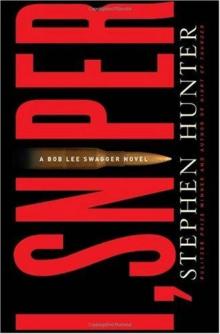 I, Sniper
I, Sniper Havana
Havana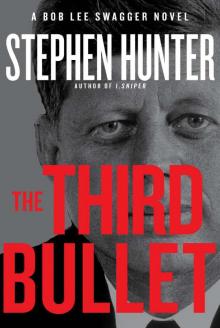 The Third Bullet
The Third Bullet Sniper's Honor: A Bob Lee Swagger Novel
Sniper's Honor: A Bob Lee Swagger Novel Dirty White Boys
Dirty White Boys The 47th Samurai
The 47th Samurai Hot Springs
Hot Springs G-Man
G-Man Black Light
Black Light Time to Hunt
Time to Hunt The Day Before Midnight
The Day Before Midnight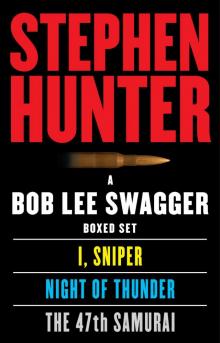 A Bob Lee Swagger Boxed Set
A Bob Lee Swagger Boxed Set The Master Sniper
The Master Sniper Game of Snipers
Game of Snipers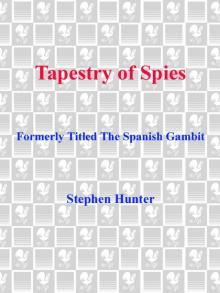 Tapestry of Spies
Tapestry of Spies Citadel
Citadel The Second Saladin
The Second Saladin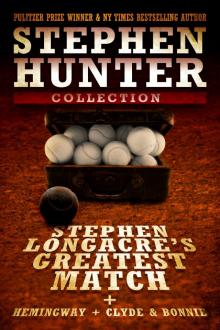 Stephen Longacre's Greatest Match
Stephen Longacre's Greatest Match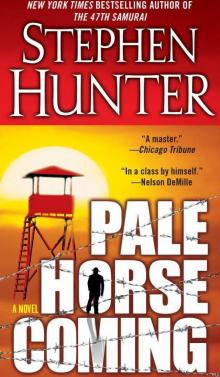 Pale Horse Coming
Pale Horse Coming Soft Target
Soft Target Dead Zero
Dead Zero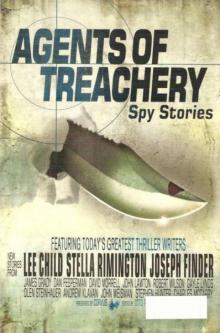 Casey at the Bat
Casey at the Bat The Third Bullet bls-8
The Third Bullet bls-8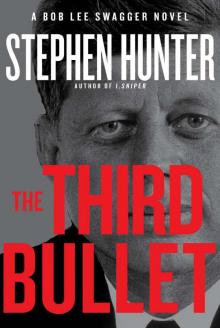 The Third Bullet: A Bob Lee Swagger Novel
The Third Bullet: A Bob Lee Swagger Novel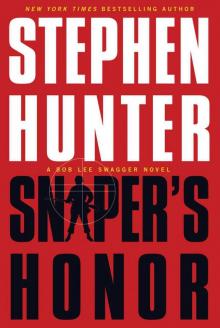 Sniper's Honor
Sniper's Honor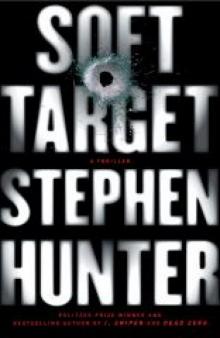 Soft target rc-1
Soft target rc-1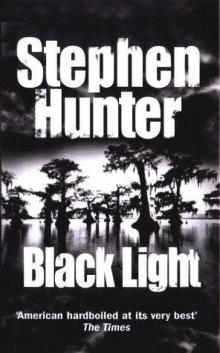 Black Light bls-2
Black Light bls-2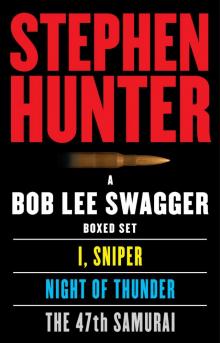 A Bob Lee Swagger eBook Boxed Set: I, Sniper, Night of Thunder, 47th Samurai
A Bob Lee Swagger eBook Boxed Set: I, Sniper, Night of Thunder, 47th Samurai Havana es-3
Havana es-3 Hot Springs (Earl Swagger)
Hot Springs (Earl Swagger)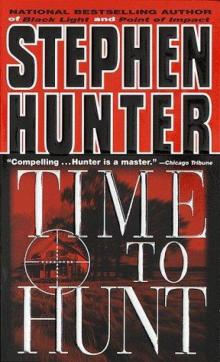 Time to Hunt bls-1
Time to Hunt bls-1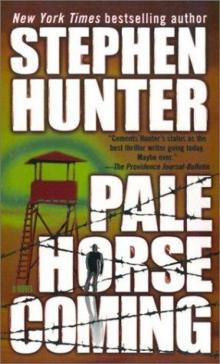 Pale Horse Coming es-2
Pale Horse Coming es-2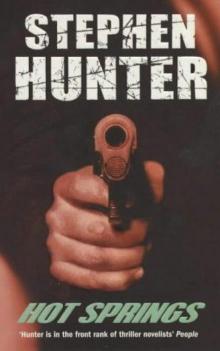 Hot Springs es-1
Hot Springs es-1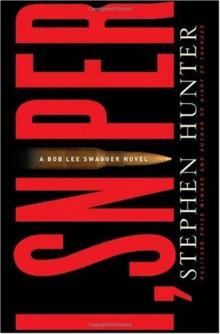 I, Sniper: A Bob Lee Swagger Novel
I, Sniper: A Bob Lee Swagger Novel